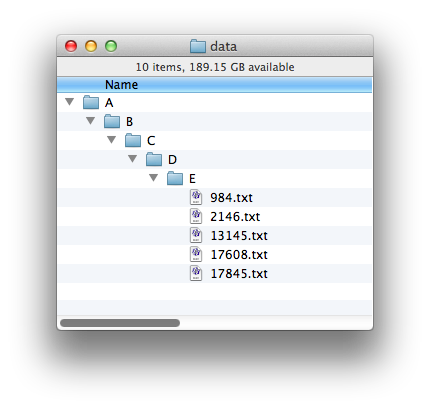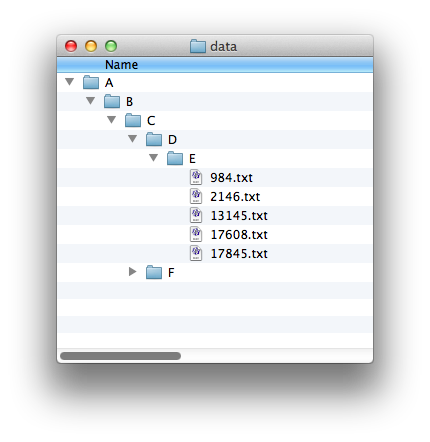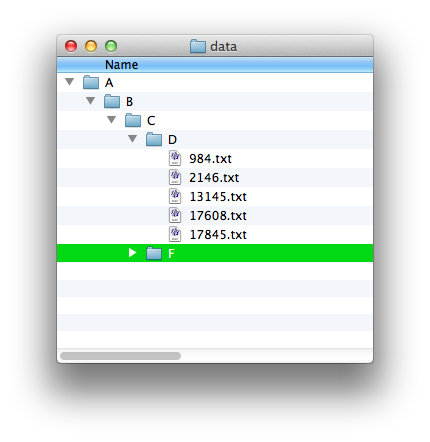I often run into situations where I have directories that contain only one file, a subdirectory, with contain only one file, a subdirectory, and so on for a long chain, until I get to the interesting files. These situations come up when I have only part of a data set so the files that would be in other directories aren’t there, and I find it annoying to deal with these long directory specifications. So, this challenge is to fix that by collapsing those one-entry directories into a single one.
For example, you should take this structure, where you have A/B/C/D/E in a direct line with no other branches:

and turn it into this one, with a single directory with the files that were at the end:

However, you should only moves files up if the directory above it has only one entry (which must be a subdirectory!). In this example, A/B/C has two subdirectories in it:

so the the files in E should only move up into D. Otherwise, the files from the two branches in C would get mixed up with each other.

In the second example, shouldn’t D and F end up in A, since B contains *only* C?
I hadn’t thought about that. I’ll let you decide!
#!/usr/bin/perl use strict; use warnings; use File::Path qw(remove_tree); use File::Copy qw(move); my ($dir) = @ARGV; short_dir($dir) ; sub short_dir { my ($start, $now) = @_; return unless(-d $start); $now ||= $start; my @subnodes = glob("$now/*"); my @subdirs = grep { -d $_ } @subnodes; if($#subdirs>0){ short_dir($_) for @subdirs; }elsif($#subdirs==0){ short_dir($start, $subdirs[0]); }else{ return if($start eq $now); move($_, "$start/") for @subnodes; my @dirs = grep { -d $_ } glob("$start/*"); remove_tree($dirs[0]); } }Not as easy as it seems. My solution works as Szymon proposed. Some details would still need discussion with the client, though 🙂 For example, each empty directory without siblings disappears. The script probably does not work correctly for /, but I did not have enough courage to test it. Also, I might have used a bit more than Learning Perl teaches – I have read more books.
#!/usr/bin/perl use warnings; use strict; use Cwd 'abs_path'; use constant SELF_OR_PARENT => qr/^\.\.?$/; sub collapse { my $dir = shift; opendir my($DH), $dir; my $count = 0; my $previous; DIR: while (my $file = readdir $DH) { next DIR if $file =~ SELF_OR_PARENT; last DIR if ++$count > 1; $previous = $file; } if ($count == 1 and defined $previous and -d (my $fullpath = "$dir/$previous") ) { my ($path, $dirname) = $dir =~ m=(.*)/(.*)=; rename $fullpath, "$dir/../_$dirname" or die $!; rmdir $dir or die $!; rename "$path/_$dirname", $dir or die $!; collapse($dir); } else { opendir my ($DH), $dir; while (my $subdir = readdir $DH) { collapse("$dir/$subdir") if -d "$dir/$subdir" and $subdir !~ SELF_OR_PARENT; } } } my $top = shift; die "$top is not a dir" unless -d $top; $top = abs_path($top); collapse($top);I’m mainly a C++ programmer, but I tried my hand at perl this time. I used a recursive function and shell commands.
#!/usr/bin/perl sub checkAndDelete{ if(!(-d $_[0])){ return; } my $command="ls ".$_[0]; $scc=`$command`; $scc=~s/ /\n/; my @files=split("\n",$scc); my $size=@files; my $fprefix=$_[0]; my $lastc=substr($fprefix,-1); if(!($lastc eq "/")){ $fprefix=$fprefix."/"; } if($size==1 and -d(($fprefix.$files[0]))){ my $cpcom="cp -a ".$fprefix.$files[0]."/. ".$fprefix; print($cpcom."\n"); system($cpcom); system("rm -r ".$fprefix.$files[0]); } @files=split("\n",(`$command`)); $size=@files; for(my $i=0;$i<$size;$i++){ &checkAndDelete(($fprefix.$files[$i])); } } @ARGV>0 or die 'Insufficient arguments'; -d $ARGV[0] or die 'Incorrect path'; &checkAndDelete($ARGV[0]);